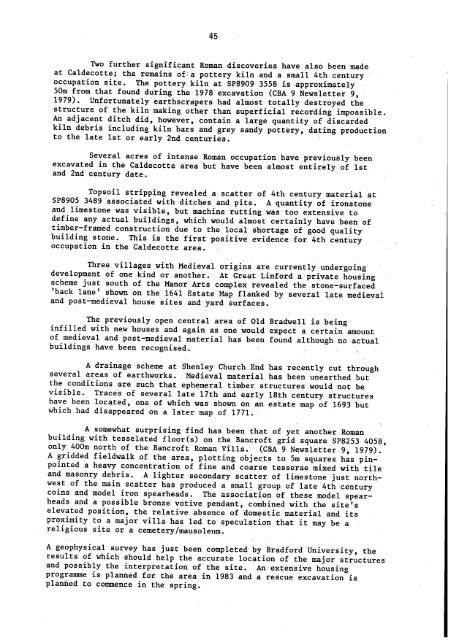CBA SMA\SMA 1983.PDF - Council for British Archaeology
CBA SMA\SMA 1983.PDF - Council for British Archaeology
CBA SMA\SMA 1983.PDF - Council for British Archaeology
You also want an ePaper? Increase the reach of your titles
YUMPU automatically turns print PDFs into web optimized ePapers that Google loves.
45<br />
Two further significant Roman discoveries have also been made<br />
at Caldecotte; the remains of a pottery kiln and a small 4th century<br />
occupation site. The pottery kiln at SP8909 3558 is approximately<br />
50m from that found during the 1978 excavation (<strong>CBA</strong> 9 Newsletter 9,<br />
1979). Un<strong>for</strong>tunately earthscrapers had almost totally destroyed the<br />
structure of the kiln making other than superficial recording impossible.<br />
An adjacent ditch did, however, contain a large quantity of discarded<br />
kiln debris including kiln bars and grey sandy pottery, dating production<br />
to the late 1st or early 2nd centuries.<br />
Several acres of intense Roman occupation have previously been<br />
excavated in the Caldecotte area but have been almost entirely of 1st<br />
and 2nd century date.<br />
Topsoil stripping revealed a scatter of 4th century material at<br />
SP8905 3489 associated with ditches and pits. A quantity of ironstone<br />
and limestone was visible, but machine rutting was too extensive to<br />
define any actual buildings, which would almost certainly have been of<br />
timber-framed construction due to the local shortage of good quality<br />
building stone. This is the first positive evidence <strong>for</strong> 4th century<br />
occupation in the Caldecotte area.<br />
Three villages with Medieval origins are currently undergoing<br />
development of one kind or another. At Great Lin<strong>for</strong>d a private housing<br />
scheme just south of the Manor Arts complex revealed the stone-surfaced<br />
'back lane shown on the 1641 Estate Map flanked by several late medieval<br />
and post-medieval house sites and yard surfaces.<br />
The previously open central area of Old Bradwell is being<br />
infilled with new houses and again as one would expect a certain amount<br />
of medieval and post-medieval material has been found although no actual<br />
buildings have been recognised.<br />
A drainage scheme at Shenley Church End has recently cut through<br />
several areas of earthworks. Medieval material has been unearthed but<br />
the conditions are such that ephemeral timber structures would not be<br />
visible. Traces of several late 17th and early 18th century structures<br />
have been located, one of which was shown on an estate map of 1693 but<br />
which had disappeared on a later map of 1771.<br />
A somewhat surprising find has been that of yet another Roman<br />
building with tesselated floor(s) on the Bancroft grid square SP8253 4058,<br />
only 400m north of the Bancroft Roman Villa. (<strong>CBA</strong> 9 Newsletter 9, 1979).<br />
A gridded fieldwalk of the area, plotting objects to 5m squares has pinpointed<br />
a heavy concentration of fine and coarse tesserae mixed with tile<br />
and masonry debris. A lighter secondary scatter of limestone just northwest<br />
of the main scatter has produced a small group of late 4th century<br />
coins and model iron spearheads. The association of these model spearheads<br />
and a possible bronze votive pendant, combined with the site's<br />
elevated position, the relative absence of domestic material and its<br />
proximity to a major villa has led to speculation that it may be a<br />
religious site or a cemetery/mausoleum.<br />
A geophysical survey has just been completed by Brad<strong>for</strong>d University, the<br />
results of which should help the accurate location of the major structures<br />
and possibly the interpretation of the site. An extensive housing<br />
programme is planned <strong>for</strong> the area in 1983 and a rescue excavation is<br />
planned to commence in the spring.

















